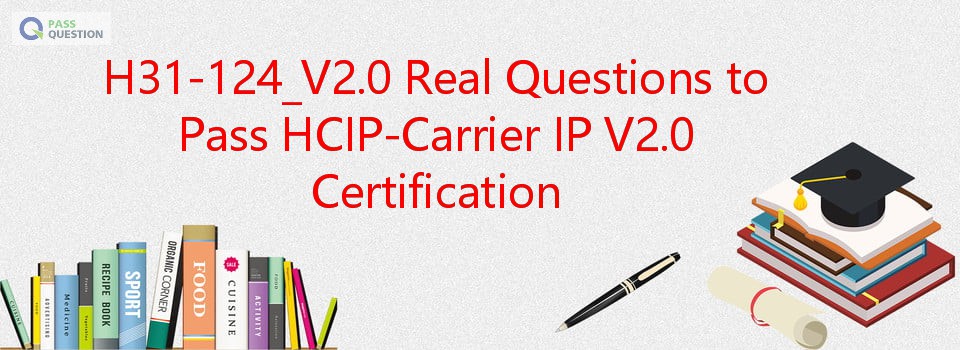H31-124_V2.0 Real Questions to Pass HCIP-Carrier IP V2.0 Certification
If you are going to prepare for your HCIP-Carrier IP V2.0 H31-124_V2.0 exam, you can get H31-124_V2.0 Real Questions from PassQuestion which has 95% similarity with the real exam for learning. The accuracy rate of H31-124_V2.0 questions and answers provided by PassQuestion is very high and they can 100% guarantee you pass the exam successfully for one time. PassQuestion is the best source to prepare for your HCIP-Carrier IP V2.0 Certification H31-124_V2.0 exam for 100 percent results.

HCIP-Carrier IP V2.0 Certification Exam Overview
HCIP-Carrier IP certification is positioned to validate the knowledge about common protocols, reliability technologies, WAN access technologies, security, and mainstream networking and services of carriers in the IP network of the operation network, and the capabilities for network configuration and troubleshooting.
With an HCIP-Carrier IP certification, you demonstrate the systematic understanding and good command of the common technologies and protocol principles of the IP network, the knowledge about the typical LAN, backbone network and the typical services of carriers, and the capabilities for service configuration and maintenance of carriers' LANs and WANs.
HCIP-Carrier IP V2.0 Exam Content
Layer 2 Ethernet technologies, VLAN technology, QinQ technology, and VXLAN technology, HA technologies including ETH-Trunk and FRR, multicast technologies, PPP and PPPoE access technologies, AAA technology and BRAS and basic firewall knowledge, QoS technology, OSPF, IS-IS, BGP routing protocols, route control and selection, IPv6 basics and routing protocols, Segment Routing, MPLS VPN, EVPN, and MPLS TE technology, SDN and NFV basics, Home broadband and video solutions, and VDC solution.
- Hardware, Ethernet and VLAN Technology 10%
- High Availability (HA) 10%
- Multicast Protocols 5%
- Access and Authentication Techniques 10%
- Firewall Basic Principles 4%
- QoS 5%
- .Layer 3 IP advanced routing 32%
- MPLS, Tunnel Technologies 12%
- VPN Technologies 6%
- Network and service evolution 6%
View Online HCIP-Carrier IP V2.0 H31-124
1. Which of the following statements regarding Attachment Bit are correct?
A. The Attachment Bit can be generated in Level-2 LSP.
B. The Attachment Bit can be generated by the Level-2 or Level-1-2 router.
C. The Attachment Bit is carried In Level-1 LSP generated by Level-1-2 router connected to another area.
D. After the Level! router receives Level-1 LSP with Attachment bit set to 1, it will generates default route with the nearest Level-1-2 router as the next hop.
Answer: C,D
2. Which of the following statement are correct regarding TTL value in VRRP packet?
A. The TTL value of device from different manufactures is different; on VRP, the TTL value is 1.
B. The VRRP packet is only forwarded in one IP network, so the TTL value is always set to 1.
C. The TTL value must be 255 In normal VRRP packet.
D. By default, the VRRP packet with TTL value not equal to 255 will be dropped; On VRP, we can use some commands to disable the function of delecting TTL value.
Answer: C,D
3. VXLAN uses MAC in UDP encapsulation to extend Layer 2 networks and encapsulates Ethernet packets on IP packets. When packets are transmitted on a routed network, the intermediate touting device does not need to learn inner MAC addresses.
A. True
B. False
Answer: A
4. How does MPLS BGP VPN handle the problem of address overlapping of different VPN sites?
A. To maintain separate VRF lor different VPN.
B. To allocate unique RD for each VPN.
C. To use different routing protocols In the backbone network for afferent VPN.
D. To allocate different LSP for each VPN.
E. To allocate unique RT for each VPN.
Answer: A,B
5. Which of the following statements about CAR are correct?
A. CAR uses token bucket mechanism to measure traffic and allocate bandwidth.
B. CAR can be used for incoming interface and outgoing interface.
C. CAR can be used to limit the rate of the specific type of traffic.
D. CAR and queue scheduling cannot be used at the same time because of confliction.
Answer: A,B,C
6. There are two MAC address learning modes in the VPLS: unqualified and qualified. In qualified mode, all VLANs are processed by the same VSI and they share the same broadcast domain or MAC address space.
A. True
B. False
Answer: B
- TOP 50 Exam Questions
-
Exam
All copyrights reserved 2025 PassQuestion NETWORK CO.,LIMITED. All Rights Reserved.

